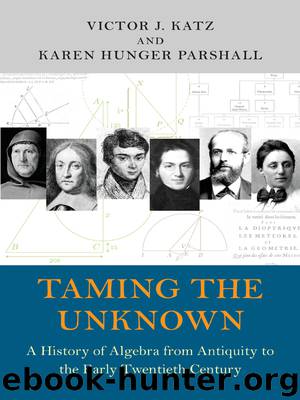Taming the Unknown by Parshall Karen Hunger Katz Victor J

Author:Parshall, Karen Hunger, Katz, Victor J.
Language: eng
Format: epub
Publisher: Princeton University Press
Published: 2014-03-14T16:00:00+00:00
Figure 10.3.
He thus began with a single axis NZM and a linear equation (figure 10.3). (Note that he adhered closely to Viète’s notation: vowels for unknowns; consonants for knowns; “in” to represent “times”; and no symbol for “equals.”) To show that his equation, written in modern notation as dx = by, represents a straight line, he used basic geometry:
Indeed, we have B to D as A to E. Therefore, the ratio A to E is given, as is also the angle at Z. So the triangle NIZ is given in species and the angle NIZ is also given. But the point N and the line NZ are given in position. Therefore the line NI is given in position. The synthesis is easy.
This was “easy” in the sense that it was straightforward to complete the argument by showing that any point T on NI determines a triangle TWN with NW : TW = B : D.
Although the basic notions of modern analytic geometry are apparent in Fermat’s description, his ideas differ somewhat from those now current. First, Fermat used only one axis. He thought of a curve not as made up of points plotted with respect to two axes but as generated by the motion of the endpoint I of the variable line segment ZI as Z moves along the given axis. Fermat often took the angle between ZI and ZN as a right angle, although nothing compelled that choice. Second, for Fermat as for Viète and even Harriot (at least most of the time), the only proper solutions of algebraic equations were positive. Thus, Fermat’s “coordinates” ZN and ZI—solutions to his equation D in A equals B in E—represented positive numbers, and he drew only the ray emanating from the origin into the first quadrant.
Download
This site does not store any files on its server. We only index and link to content provided by other sites. Please contact the content providers to delete copyright contents if any and email us, we'll remove relevant links or contents immediately.
| Algebra | Calculus |
| Combinatorics | Discrete Mathematics |
| Finite Mathematics | Fractals |
| Functional Analysis | Group Theory |
| Logic | Number Theory |
| Set Theory |
Modelling of Convective Heat and Mass Transfer in Rotating Flows by Igor V. Shevchuk(6406)
Weapons of Math Destruction by Cathy O'Neil(6215)
Factfulness: Ten Reasons We're Wrong About the World – and Why Things Are Better Than You Think by Hans Rosling(4713)
A Mind For Numbers: How to Excel at Math and Science (Even If You Flunked Algebra) by Barbara Oakley(3256)
Descartes' Error by Antonio Damasio(3248)
Factfulness_Ten Reasons We're Wrong About the World_and Why Things Are Better Than You Think by Hans Rosling(3216)
TCP IP by Todd Lammle(3154)
Fooled by Randomness: The Hidden Role of Chance in Life and in the Markets by Nassim Nicholas Taleb(3080)
Applied Predictive Modeling by Max Kuhn & Kjell Johnson(3041)
The Tyranny of Metrics by Jerry Z. Muller(3028)
The Book of Numbers by Peter Bentley(2929)
The Great Unknown by Marcus du Sautoy(2662)
Once Upon an Algorithm by Martin Erwig(2621)
Easy Algebra Step-by-Step by Sandra Luna McCune(2604)
Lady Luck by Kristen Ashley(2554)
Police Exams Prep 2018-2019 by Kaplan Test Prep(2516)
Practical Guide To Principal Component Methods in R (Multivariate Analysis Book 2) by Alboukadel Kassambara(2513)
All Things Reconsidered by Bill Thompson III(2371)
Linear Time-Invariant Systems, Behaviors and Modules by Ulrich Oberst & Martin Scheicher & Ingrid Scheicher(2346)
